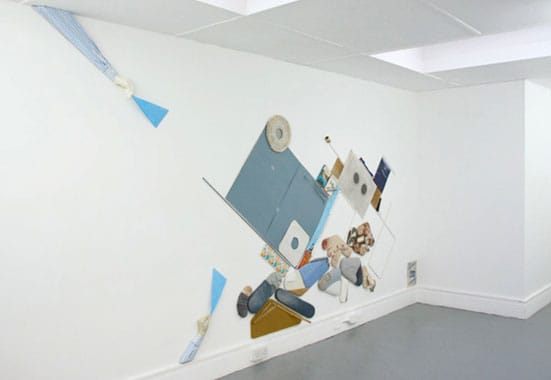19th November 2009 — 19th December 2009
For his first solo show in London, Anthony Green's work extends and clings to the walls of Limoncello like the rhizomatic tendrils of some Deleuzean triffid. In fact, though never named, Deleuze is alluded to so conspicuously in the press release – peppered as it is with the philosopher's distinctive jargon – one might be tempted to interpret the work through a wholly Deleuzean lens – to commit the work, as it were, to a Deleuzean agenda. The 'report' of the exhibition title too seems to back up this sense of lurking didacticism. However, the work itself – despite the apparent ease with which one might affix Deleuzean tropes to it (or any other philosopher for that matter) – resolutely resists any partisanship of meaning or demonstration. Rather, it seems that Green's exhibition might actually be critiquing the very risk of a hermeneutics of art.
Bits of familiar stuff (a flattened paper lantern, a record sleeve, badges, bulldog clips, jay-cloths, magazine pages) gather in crowds around familiarly shaped and processed materials (wood, foam, denim, rubber, card, plastic, plaster) which in turn give way to clearly art-like objects: expressionistic shapes and weird, protuberant pebbles, decorated in a variety of ways. These pebbles (an awkward term, but the most formally faithful I can think of) – turned and rounded by a tide somewhere – are the most singular aesthetic forms in the show, providing something of a precedent for the rest of the work; nodes to the other component's shoots. Sometimes studded with slightly raised images of noses, mouths, folded flesh; other times tightly tailored into blue-jean denim or hemmed cotton – these pebbles sit in an ambiguous space between sugar-coated pharmacological lozenge, and that more theoretical and inverted object of capitalist desire, 'organs without bodies'.
In the piece, 'A Report: The Face. A Room. Heating Up', a sordid little cluster of these liminal, libidinal objects float above a vertical layout of stuff – formally rhymed and positioned with a seemingly arbitrary 'rightness'. A familiarity of material bleeds uncomfortably into a foreignness of form, forms that are shaped by their position amongst many, rather than by their singular material content. A triangular slice of what could be the foam-lined wall of a sound studio abuts a square chunk of concrete incised with a pattern of deep furrows, and a piece of deliberately cut newspaper gridded in black ink. Individually, each component is manufactured via discrete, albeit parallel, processes that might demonstrate – through sheer ubiquity, perhaps – a particular industry, complete with its own histories, cultures and associations. In this state, however, an overview of these fragments is far more feasible than an isolated focus, the different elements becoming homogeneous in their singularity. At this height – because the half-depressed plans of Green's work might be most basically understood as somehow topographic – a pattern emerges, however convoluted. Noticing that this pattern exists seems tantamount to the ascription of meaning; interpreting that meaning however, is another matter. Like the irony of ironies that Walter Benjamin describes in 'The Concept of Criticism in German Romanticism', the recognition of a pattern or a plan or a coherent 'report' within Green's work serves to entrench the sense of mystification that, according to Benjamin, serves as a fundamental facet of art. Any systemic allusion within Green's work serves to affirm itself, over and over again – but as a form of mystification rather than elucidation.
The press release goes so far as to describe the work as 'devoid of any hidden depths or mystery'; that 'the work exists as pure surface generated from a set of contingent irrational rules informed by Green's rigorous conceptual practice'. The idea of 'contingent irrational rules' is strikingly oxymoronic, belying something perhaps deliberately ironic within Green's work. The revelation of a system of rules at work, tantalisingly glimpsed through Green's conceptual veil, is surely an example of an ironisation of the form itself: the genuine order that is at play within Green's work is that of the idea of art – the remit of art – and a belief in art's 'indestructible sublation in that idea' (Benjamin). The denial of depth within the work might then describe merely the physical shallowness of the pieces that hug the wall, daring only to protrude a little – just enough to resist the categorical ease of sculpture (an inch further), or of the drawings that are also in the show (an inch back). We might then also understand Green's latent commitment to Deleuze as a similarly ironic gesture, at least in part. Green's apparent insistence that what we are seeing in and of the work is a collection of movements rather than objects (or 'becomings', to use Deleuzean parlance) that are unceasing in their intense and sensational, positive progression – meets its determined critique in the immobility of the work itself – its clear ossification as art.
The failure of the work to actually become a diagrammatic representation of these ideas, or to enact their key tenets, is, ironically, what returns the work to its status as art – uncommitted and equivocal; whilst also alluding to some of the contrary and problematic aspects around notions of 'becoming'. It's what serves to maintain the work's position as in-between; promises of recognition and of interpretation are returned spurned, disassembled and insoluble.
Ed Atkins
Limoncello
15a Cremer Street
London E2 8HD
http://www.limoncellogallery.co.uk/
Open
Thursday-Saturday, 11am-6pm

'A Report: The Face. A Room. Heating Up', Anthony Green 2009, Mixed Media

'Another Stroll: How Can We Escape Our Petty Little Fascisms?', Anthony Green 2009, Mixed Media